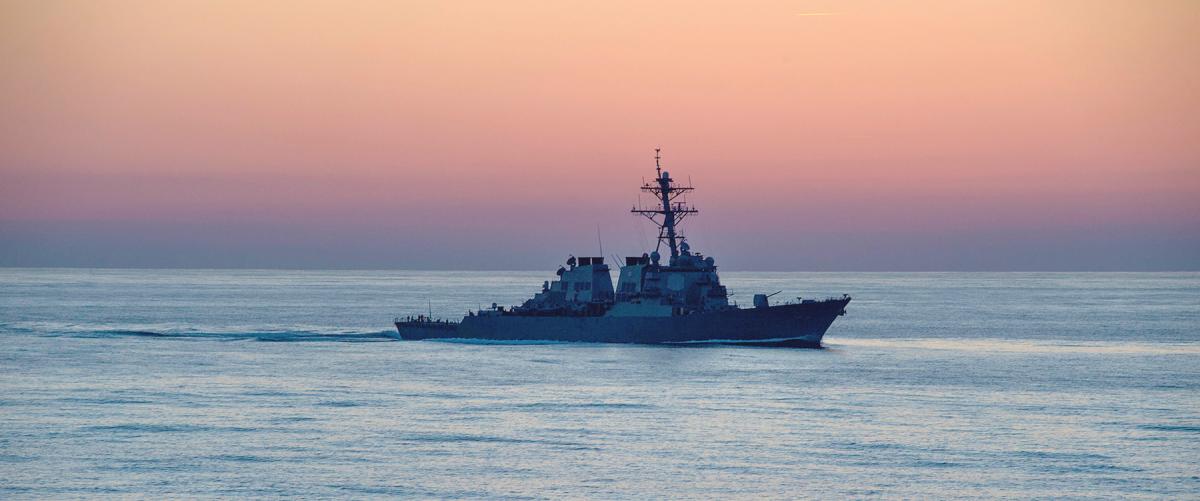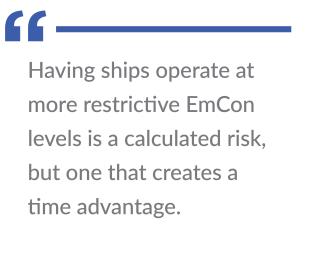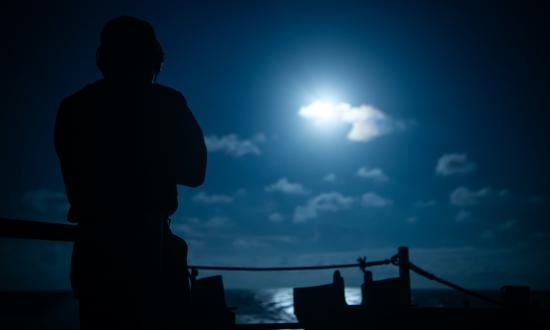Peer competition with China is now the top U.S. national security priority. In the western Pacific, the U.S. Navy is in a technologically saturated maritime domain in which China has a high capability to find, fix, track, target, and engage ships. While Navy ships have sophisticated, integrated technology that brings great capabilities to the fleet, overreliance on it has diminished basic naval seamanship skills and allowed fleet and even national headquarters to micromanage ship commanding officers.
To rectify these problems, ships must make it standard practice to leave port and immediately set a high level of emissions control (EmCon). This will not only instill in sailors a higher level of proficiency, but also greatly reduce or mask the ship’s electronic footprint, making it harder to detect by electronic means. The Navy’s ability to “disappear and reappear” its strike groups will be a force multiplier and a strategic advantage.
Developing and maintaining EmCon agility will require fleet commanders to reduce the administrative burdens on a ship underway, restricting communications and emissions to essential information at minimal intervals and granting commanding officers greater autonomy. The latter will require fleet commanders to create clear and concise operational orders without excessive overreach and micromanagement. In addition, commanding officers must maintain intimate tactical knowledge of their ships and demand a higher level of proficiency in their tactical action officers (TAOs). This creates not only more efficient and self-sufficient afloat units, but also a tactical advantage against a peer adversary. Greater autonomy at the unit level allows for swifter and more devastating actions on objectives while controlling the ever-important warfare area of time.
A New Operating Standard
The ability to detect electronic emissions at distance continues to advance. The two most common bands of military surface search radars—the X and
C bands—have maximum useable ranges of approximately 10 and 90 nautical miles, respectively. The rule of thumb for detectable range for an electronic emission is typically twice the useable range because of propagation. Thus, for each emission a ship releases, it broadcasts its position at twice the range it can “see.” But as the race for supremacy in the electronic warfare domain continues, detectable ranges will become increasingly farther from the point of origin.
Changing a naval force posture to operate at more restrictive EmCon levels more routinely would be a major shift from how the Navy currently does business. It would require task force and fleet commanders to release their tight grip on control and entrust commanding officers to do their jobs. It would also require new standard operating principles for ships, including:
• Operate at or near total emissions silence once they have exited U.S. contiguous zones or the territorial waters of friendly nations.
• Conduct a standard satellite communications check at a random interval to reduce the chance of detection or pattern recognition.
• Create a tripwire for positive identification of hostile forces or weapons that would initiate the energizing of all systems for enhanced detection and targeting capabilities. Of note, the standard equipment alignment should be to have all systems that can restrict transmitting remain energized and in standby to be brought online quickly.
During the early stages of World War II in the Pacific, Admiral Chester Nimitz introduced the concept of calculated risk to U.S. naval doctrine. In his Letter of Instruction prior to the Battle of Midway he explained “. . . the principle of calculated risk, which you shall interpret to mean the avoidance of exposure of your force to attack by a superior enemy force without good prospect of inflicting, as a result of such exposure, greater damage to the enemy.”1 History has lauded Admiral Nimitz’s principle as well as the directness and simplicity in his orders to afloat commanders at Midway, which gave the U.S. Navy
the advantage over the Imperial Japanese Navy.
Having ships operate at more restrictive EmCon levels is a calculated risk, but one that creates a time advantage.
It would, however, prevent watchstanders from routinely using many electronic systems to which they have become accustomed. To offset this challenge, the Navy should invest in these five areas:
• Greater passive electronic-warfare systems and enhanced detection
capabilities.
• More capable commercial radar systems. This would allow ships to maintain surface pictures without using military-grade radars, adding to their deception capabilities.
• Point-to-point intranet systems for ships in strike groups. The systems would use stand-alone laptops with
Linux-based software (allowing for
easy modification to enhance capabilities) and rapid-flashing lasers to minimize detection. Brno University of Technology in the Czech Republic has researched using fiberless optical communications within the telecommunications industry.2
• Drones that enhance intelligence, surveillance, and reconnaissance (ISR) height-of-eye capabilities, have embedded electronic warfare suites, and add greater capability to deceptive-lighting operations. The Smart Aerial Monitoring System Tethered (SAMS-T) would provide unlimited flight time and a 320-foot data-over-power enhanced tether for resilient, jam-resistant data security even in GPS-denied environments. Outfitting ships with five of these units (or one SAMS-T and four SAMS-T Minis, which also have a 320-foot tether) would increase ships’ organic ISR capabilities. The drones’ sidelight/sternlight/masthead-like lights would also provide a wider range of deceptive lighting
options.3
• Magnetic anomaly detection systems that allow ships to detect aircraft, similar to how magnetometers detect submarines. Magnetometers measure an anomaly in the Earth’s magnetic field, like one caused by a massive hunk of metal, and give indications of a suspicious object. Magnetometers have detected submarines since World War II. Technology to detect magnetic anomalies in the sky to get advanced warning of aircraft would provide a tactical advantage to unit commanders.
The Navy’s common operating procedures must change from a fleet-directed environment with top-heavy control to ones that fully embrace command by negation and decentralization to ensure ships operate with the smallest electronic signatures possible. In doing so, they will be able to move faster and maintain the element of surprise for swift and violent combat.
1. CAPT Robert C. Rubel, USN, “Deconstructing Nimitz’s Principle of Calculated Risk,” Naval War College Review 68 (Winter 2015): 1.
2. Rob Cameron, “The Potential of Laser for Data Transfer,” DW, 2015, www.dw.com/en/the-potential-of-laser-for-data-transfer/a-18792846.
3. “Autonomous Drone-In-A-Box Solutions,” www.icarosgeospatial.com, 2021.







